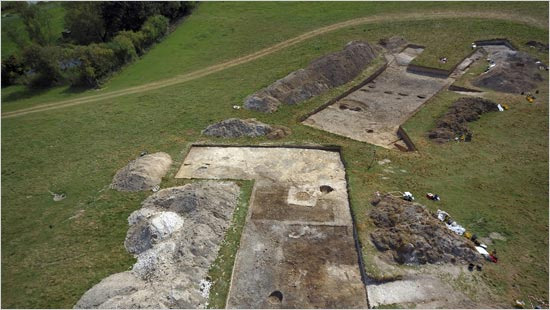 |
 |
 |
 Travel & Outdoors | January 2007 Travel & Outdoors | January 2007  
'Wooden Version' of Stonehenge Discovered
 John Noble Wilford - Herald Tribune John Noble Wilford - Herald Tribune


| | Clay floors of 4,600-year-old Neolithic houses discovered recently that may have been homes of the builders of Stonehenge. (Adam Stanford/Associated Press) |

New excavations near Stonehenge have uncovered hearths, timbers and other remains of what archaeologists say was probably the village of workers who erected the brooding monoliths on Salisbury Plain in England.

The archaeologists announced Tuesday that the 4,600-year-old ruins appear to form the largest Neolithic village ever found in Britain. The houses at the site known as Durrington Walls were constructed in the same period that Stonehenge, less than two miles, or about three kilometers, away, was built presumably as a religious center for worshipers of the sun and their ancestors.

Mike Parker Pearson, a leader of the excavations from Sheffield University, said the discoveries last summer supported the emerging recognition that the ring of standing stones and earthworks at Stonehenge was part of a much larger religious complex.

In a teleconference conducted by the National Geographic Society, Parker Pearson said a circle of ditches and earthen banks at Durrington Walls enclosed concentric rings of huge timber posts and that this was "basically a wooden version of Stonehenge."

The excavations exposed not only the timber circle but also a roadway paved with stone leading to the Avon River, about 500 feet, or 150 meters, away, which was similar to the river road from Stonehenge. The evidence, Parker Pearson said, "shows us these two monuments were complementary" and that "Stonehenge was just one-half of a larger complex."

The project, begun in 2003, is exploring the wider landscape of the Stonehenge World Heritage site, about 100 miles southwest of London. The research is directed by six British universities and financed in part by the National Geographic.

Over the years, mystical Stonehenge has inspired a wild range of conjecture, though it is now assumed that this was a place of worship that seemed to be related to solar cults. A decade ago, more precise radiocarbon tests dated the first constructions at Stonehenge to 2600 to 2400 B.C., more than 600 years earlier than previous estimates. The houses at Durrington Walls have been dated to 2600 to 2500 B.C.

Eight houses were discovered last September, and a survey detected buried traces of many more, the archaeologists said. Each house, constructed of wattle and daub, was no bigger than 14 to 16 feet square and had a hard clay floor and a central fireplace. Indentations in the floor were interpreted as slots that once anchored furniture.

The occupants were a messy lot, the excavators concluded. Debris of broken pots and jars and animal bones was everywhere. Some of the people may have been builders of Stonehenge, the archaeologists surmised, and others may have been pilgrims to the sacred complex.

By contrast, in a western part of the Durrington site, Julian Thomas of Manchester University found neater remains of houses. The two excavated so far were small, neat structures, each surrounded by its own ditch and timber fence. Thomas said these may have been dwellings of special people, chiefs or priests. Or their cleanliness may mark them as not living quarters at all, but places set aside as shrines and cult centers.

Both Parker Pearson and Thomas emphasized the importance of the Durrington roadway to the Avon in understanding the two sites' intimate connection as part of a broader religious complex.

They said the road was paved with flint and led straight from the Durrington enclosure to the river bank. A similar road at Stonehenge, discovered in the 18th century, is aligned on the midsummer solstice sunrise, the archaeologists noted, while the one at Durrington lines up with the midsummer solstice sunset. Similarly, the Durrington timber circle was aligned with midwinter solstice sunrise, while a giant stone monument at Stonehenge frames the midwinter solstice sunset. | 
 | |
 |



